Abstract
Understanding the reduction of CO2 and the origin and evolution of early life on Earth is an important research endeavor. Pyrite, due to its semiconductor properties, is believed to play a pivotal role as a reactant or catalyst in converting reducing gases, such as CO2, into organic matter. In this study, we employed density functional theory (DFT) to investigate the reduction of CO2 in the presence of H2S on the surface of pyrite. Our findings reveal that the presence of sulfur vacancies enhances the adsorption of H2S and CO2 molecules onto the pyrite surface. Interestingly, we observed the generation of the HCOOH molecule on the defective pyrite surface. Additionally, the transition state analysis indicates that H2S and CO2 molecules require the overcoming of an energy barrier (Ea) of 36.93 kJ/mol to form the HCOOH molecule. This study sheds light on the role of pyrite in the early creation of life on Earth by elucidating its impact on the reduction of carbon dioxide.
1. Introduction
In recent years, the increase in greenhouse gas emissions, particularly carbon dioxide (CO2), has led to significant environmental and ecological challenges. The photocatalytic reduction of CO2 has emerged as a promising method to mitigate these issues [1,2,3]. Likewise, hydrogen sulfide (H2S), a toxic gas often co-existing with CO2, has gained considerable attention [4,5]. Furthermore, the transformation of reducible gases such as methane (CH4), H2S, and CO2 into energy sources for early life on Earth has captured the interest of researchers studying the origin and evolution of primitive life forms. The role of minerals in this process has been comprehensively investigated, with studies utilizing various analytical techniques and density functional theory (DFT) to substantiate the ability of elemental sulfur (S0), a prevalent mineral in terrestrial hot springs, to reduce CO2 into formic acid (HCOOH) under ultraviolet (UV) light below 280 nm [6,7]. These findings demonstrate how minerals can act as reactants or catalysts, aiding the formation and accumulation of organic matter, which is crucial for the emergence, survival, and evolution of primitive cells. Similar conclusions are drawn by Sharma et al. [8].
Semiconductor minerals, characterized by their appropriate band gaps, have garnered particular attention in the study of the reduction of CO2. Pyrite with a bandgap of 0.95 eV [9] is a representative example of a semiconductor mineral. Zhang et al. [10] studied the reduction of CO2 into HCOOH on the surface of ZnS colloidal particles in aqueous solutions under UV light, discovering an initial quantum efficiency of 10% for HCOOH production from CO2 at pH 6.3. The reaction rate was found to be pH-sensitive, increasing with acidity in the pH range of 5–9. These findings suggest that photochemical reactions on the colloidal particles’ surface may have played a vital role in the synthesis of organic molecules. Li et al. [1] reported when the amount of copper oxide loading on TiO2, led to the best yield of methanol and ethanol, and thought that the redistribution of photogenerated charge carriers in CuO/TiO2 facilitates electron trapping and prohibits the recombination of electrons and holes, which significantly increases photo-efficiency. Scribano et al. [11] support the significance of pyrite as a key mineral in abiogenesis, exemplified by the reaction
CO2 (aq) + FeS + H2S → HCOOH + FeS2 + H2O
Based on the above equation, He et al. [12] demonstrated that the formation of HCOOH is a result of the presence of H2S, which is a reductant. In addition, the H2O molecule has been found to act as a hydrogen donor in CO2 reduction. Liu [13] found that the transfer of hydrogen to COx in the form of H2S at low temperatures was not feasible kinetically, while the adsorption of CO2 on the surface of silicon-activated H2S can produce HCOOH.
As a widely occurring sulfide ore in nature, pyrite has been a hot topic of research [14,15,16,17,18,19,20,21,22,23,24,25,26]. However, defects such as impurity-bearing and vacancy are often observed in the mineralization of pyrite. Nair et al. [18] and Liu et al. [19] found that the presence of sulfur vacancies obviously increases the adsorption behavior of water-oxygen molecules on the surface of pyrite. Are surface defects favorable for the formation of HCOOH from CO2? Therefore, in this paper, we investigated the adsorption behavior of H2S and CO2 molecules on the perfect and defective pyrite surface, expecting to provide a theoretical basis for research on the reduction of CO2 and the origin of life.
2. Parameters and Models of Theoretical Calculation
In this calculation, the GGA–PW91 functional CASTEP module based on the first principal theory [27,28] in Materials Studio software is selected. The ultrasoft pseudopotential is chosen to calculate the valence electrons of Fe and S atoms (Fe 3d64s2 and S 3s23p4) [29]. The cutoff energy is tested as 350 eV. Other parameters: the convergence tolerance energy, the max force, the max stress, and the max displacement are 2.0 × 10–5 eV/atom, 0.05 eV/Å, 0.1 GPa, 0.002 Å, respectively. The k-point is set as 1 × 2 × 1. The band gap of bulk pyrite is 1.01 eV, which is consistent with Zhang et al.’s results [30]. The transition state (TS) is searched using the complete linear/quadratic synchronous transit (LST/QST) [31] for each reaction.
In our previous published paper [32], the surface energy of different atomic layer numbers and vacuum layer thicknesses was tested. It was found that the pyrite surface with 15 atomic layers and 1 nm vacuum thickness has a lower surface energy and stable structure. Therefore, the 3 × 2 × 1 supercell with a vacuum layer thickness of 15 Å was constructed, which contains 15 atomic layers. In the calculation process, the bottom nine atom layers were constrained. In addition, we found that the difference between 1 nm and 1.5 nm vacuum thickness is small. In order to simulate the calculation of the transition state, the 1.5 nm vacuum thickness was selected in this manuscript. As shown in Figure 1a, S and Fe atoms on the pyrite (100) surface belong to tri- and penta-coordinated structures, respectively. For the S-vacancy defective pyrite (100) surface, due to the absence of an S atom, two tetra-coordinated Fe atoms and one coordinate S atom are formed on the surface. H2S and CO2 molecules were placed inside a cubic box with lengths of 10 Å × 10 Å × 10 Å for optimization, before adsorption on the mineral surface.
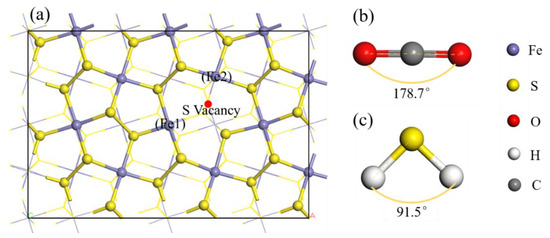
Figure 1.
Optimized configuration of the defective pyrite (100) surface containing the S-vacancy (a), CO2 (b), and H2S (c).
The equation of the adsorption energy of the molecule is shown in Equation (2):
Eads = Emolecule/surface − (Emolecule + Esurface)
In the formula, the Eads is the adsorption energy, Emolecule, Esurface, and Emolecule/surface represent the energy of the CO2 or H2S molecule, the surface energy before adsorption, and the energy of the surface-adsorbed molecule, respectively.
3. Results and Discussion
3.1. H2S Molecule Adsorbed on Pyrite Surface
In the studies conducted by Stirling et al. [20] and Kolos et al. [23], the adsorption properties of H2S on the surface of pyrite were investigated. The authors observed that H2S tends to preferentially undergo molecular adsorption on the Fe sites. In this study, two adsorption configurations of H2S on the perfect pyrite surface are considered and shown in Figure 2. Upon comparing Figure 2a with 2b, it was found that H2S molecules have a preference for molecular adsorption on the Fe site, where the Fe-S distance was found to be approximately 2.288 Å. On the contrary, the S site exhibited lower favorability for the adsorption of the H2S molecule. These findings align closely with the results presented by Stirling et al. [20], who reported a Fe–S distance of approximately 2.344 Å and an H–S–H angle of approximately 91.9°. Regarding the adsorption energy, Kolos et al. [23] calculated the adsorption energy of a H2S molecule on the pyrite surface to be around −80 kJ/mol, which is slightly lower than the result obtained in this study (−68.99 kJ/mol). Furthermore, Stirling et al. [20] indicated that no dissociative adsorption behaviors of the H2S molecule were observed on the perfect surface, which is consistent with the findings presented in this study.
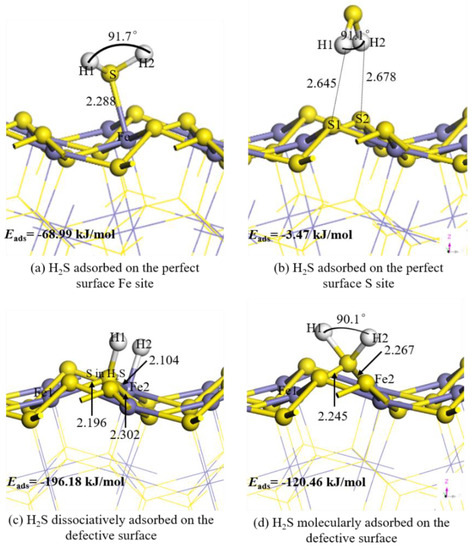
Figure 2.
Adsorption result of an isolated H2S molecule on the perfect and defective pyrite surface. Note: the number represents the bond length in Å.
In contrast, Figure 2c,d demonstrate that the dissociative adsorption of H2S molecules can occur on defective pyrite surfaces containing S vacancies. Figure 2c shows the formation of –H and –SH species, with the –H species being adsorbed on the Fe site of the surface, while the –SH species fills the vacancy by forming two Fe–S bonds with distances of 2.104 Å and 2.196 Å, as well as an S-S bond with a distance of 2.302 Å. Additionally, when the molecular adsorption of the H2S molecule is on the defective pyrite surface containing a S vacancy, the S atom bonds with two Fe atoms, and the angle of H–S–H decreases from 91.5° to 90.1°. Upon comparing Figure 2c and 2d, it is evident that the adsorption energy of the dissociative adsorption of H2S molecules on the defective pyrite surface containing a S vacancy is more negative than that of molecular adsorption, suggesting that the behaviors of a dissociative adsorption are more likely to occur. Furthermore, Figure 2 reveals that the adsorption energy of H2S molecules on the defective pyrite surface is more negative than that on the perfect surface, indicating that the presence of a S vacancy is favorable for the adsorption of H2S molecules. The viewpoint proposed by Guevremont et al. [33], in which S vacancies are favorable for the adsorption of H2O and H2S molecules on the pyrite surface, was verified through the use of DFT, X-ray photoelectron spectroscopy (XPS), temperature programmed desorption (TPD), and the photoemission of adsorbed xenon (PAX).
The electron density of the perfect part and the defective part of adsorbed H2S on the defective surface containing a S vacancy was compared and the result is shown in Figure 3. As shown in Figure 3, the interaction between the S atom in the H2S molecule and Fe1/Fe2 atom is similar to that between the S atom on the surface and Fe atoms, while the interaction between the S atom in the H2S molecule and the S atom on the surface is slightly less than that of the S–S bond of the perfect surface. This observation further supports the notion that a dissociative adsorption of the H2S molecule on the defective surface containing a S vacancy is the strongest.
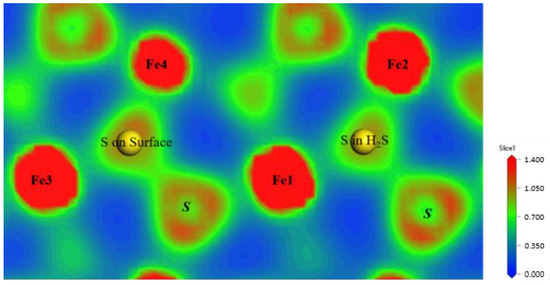
Figure 3.
The electron density of the perfect part and the defective part of adsorbed H2S on the S-vacancy defective surface.
3.2. CO2 Molecule Adsorbed on Pyrite Surface
Previous studies have extensively investigated the adsorption of CO2 on various metal oxide [34,35] and sulfide surfaces [22,36]. For instance, Khaledialidusti et al. [36] studied the adsorption behavior of CO2 on the chalcopyrite (110) surface and reported both molecular and dissociative adsorption. The adsorption energy for the CO2 molecule on different surface sites ranged from −11.7 kJ/mol to −29.8 kJ/mol. However, in our study, it was found that on the perfect pyrite surface, when CO2 adsorbs on the S-S site, S site, and Fe-Fe site, the CO2 molecules are located more than 3 Å above the surface, and the adsorption energy is positive, indicating an unfavorable adsorption configuration (see Figure S1). As shown in Figure 4a, the CO2 molecule adsorbs on the Fe site of the perfect pyrite surface with an adsorption energy of −7.39 kJ/mol. The CO2 molecule adopts a slightly bent conformation with an angle of 177.74°. The Fe–O bond with a distance of 2.293 Å is formed along the Fe–S bond. This suggests that the interaction between the CO2 molecule and the perfect pyrite surface is primarily attributed to physical adsorption.
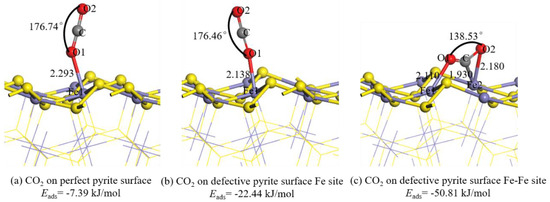
Figure 4.
Adsorption result of an isolated CO2 molecule on the perfect and defective pyrite surface. Note: the number represents the bond length in Å.
As shown in Figure 4b,c, the adsorption energy of the CO2 molecule on the Fe site and Fe-Fe site of the defective pyrite surface containing a S vacancy is −22.44 kJ/mol and −50.81 kJ/mol, respectively, which is less than that for the perfect surface. This result indicates that the interaction between the CO2 molecule and the defective pyrite surface is stronger than that on the perfect pyrite surface and is due to chemical adsorption. In the adsorption configuration of the CO2 molecule on the Fe–Fe site, (see Figure 4c) the Fe1 and Fe2 atoms around a S vacancy bond with the two O atoms of the CO2 molecule, and the Fe2 atom bonds with the C atom of the CO2 molecule. The bond length of the Fe1–O1, Fe2–O2, and Fe2–C is 2.110 Å, 2.180 Å, and 1.930 Å, respectively. This newly formed Fe–C bond is a phenomenon not found in the former for the adsorption of the CO2 molecule on the pyrite surface. In addition, the angle of the CO2 molecule changed from 178.70° to 138.53°. This result is consistent with the report of Wu et al. [37] about the adsorption of the CO2 molecule on the Cu2O (111) oxygen-vacancy surface. They also found that C–Cu and O–Cu were formed and the angle of the ∠OCO decreased from 179.16° to 133.34°.
In contrast, on the defective pyrite surface containing a sulfur vacancy, the adsorption energy of the CO2 molecule on the Fe site and Fe–Fe site is −22.44 kJ/mol and −50.81 kJ/mol, respectively, which is lower than that on the perfect surface. This indicates a stronger interaction between the CO2 molecule and the defective pyrite surface, indicative of chemical adsorption. In the adsorption configuration of the CO2 molecule on the Fe-Fe site (see Figure 4c), the Fe1 and Fe2 atoms around the sulfur vacancy form bonds with the two O atoms of the CO2 molecule, while the Fe2 atom also bonds with the C atom of the CO2 molecule. The bond lengths of Fe1–O1, Fe2–O2, and Fe2–C are 2.110 Å, 2.180 Å, and 1.930 Å, respectively. Notably, the formation of a Fe–C bond in this configuration is a phenomenon not observed in the previous adsorption of CO2 on the pyrite surface. Additionally, the angle of the CO2 molecule changes from 178.70° to 138.53°, a similar behavior to that observed by Wu et al. [37] for the adsorption of CO2 on the Cu2O (111) surface containing an oxygen vacancy, with the formation of C–Cu and O–Cu bonds and a decrease in the ∠OCO angle from 179.16° to 133.34°. Therefore, these findings suggest that the interaction between CO2 and the defective pyrite surface, particularly the Fe-Fe site around the sulfur vacancy, is stronger than that on the perfect pyrite surface.
It is clear that the Fe1 atom on the defective surface lost more electrons than that on the perfect surface through comparing the change of the Mulliken charge of the Fe1 atom before and after adsorption. (See Table 1) The result shows that the interaction of the CO2 molecule with the defective surface is stronger than that with the perfect surface.

Table 1.
The Mulliken charge of Fe1 atom before and after adsorption.
3.3. CO2 Molecule Adsorbed on the H2S-Preadsorbed Defective Pyrite Surface
It is interesting to note that Pan et al. [38] also conducted a study on the adsorption and activation of CO2 on the β-Ga2O3 (100) surface, focusing on the effect of hydration and oxygen vacancy. They found that the protonation of the bidentate carbonate species led to the formation of bicarbonate species on the surface of β-Ga2O3 (100) after the adsorption of CO2. This process was facilitated by the presence of H2O molecules that were absorbed to the surface, subsequently dissociating into –H and –OH. Regarding the adsorption configurations of CO2 on the defective pyrite surface adsorbed by H2S, testing was conducted, and the results are presented in Figure 5 and Figure S2. Interestingly, it was observed that neither a dissociation of the CO2 molecule nor an interaction between H2S and CO2 occurred when CO2 was adsorbed on the defective surface previously adsorbed by H2S. The Fe-O bond distances in these configurations, as shown in Figure 5a,b, were measured to be 2.258 Å and 2.179 Å, respectively, with adsorption energies of approximately −8.0 kJ/mol. These adsorption behaviors resemble those observed for CO2 on the perfect surface, as depicted in Figure 4a. In addition, as shown in Figure S2, the distances of the O1–H1 and O2–H2 for the dissociative adsorption and molecular adsorption of the H2S molecule are 2.363 Å, 2.657 Å, and 2.477 Å, 2.170 Å, respectively, and no changes for the adsorption configuration of the H2S molecule have occurred. In summary, the findings highlight that the adsorption of CO2 on the defective pyrite surface, previously adsorbed by H2S, does not lead to the dissociation of CO2 or an interaction between H2S and CO2. This suggests a lack of reactivity between the two molecules in this specific configuration.
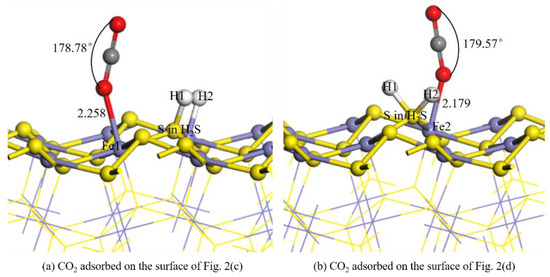
Figure 5.
Adsorption result of an isolated CO2 molecule on the defective pyrite surface where a H2S molecule is adsorbed. Note: the number represents the bond length in Å.
3.4. H2S Molecule Adsorbed on the CO2-Preadsorbed Defective Pyrite Surface
Adsorption configurations of the H2S molecule on the defective pyrite surface that is already adsorbed to by a CO2 molecule were investigated, and the results are shown in Figure 6. In the figure, it can be observed that the H2S molecule dissociates into two species: –H, which forms a bond with the O2 atom, and –SH, which forms a bond with the Fe atom by creating the Fe–S bond. This leads to the splitting of the Fe2–O2 bond. Additionally, the adsorption energy of this configuration is calculated to be −57.51 kJ/mol, suggesting that this reaction is extremely likely to occur. Furthermore, it is noteworthy that the formation of the bicarbonate species (–COOH) is observed, which aligns with the findings of Pan et al. [38]. This result demonstrates that the H2S molecule can interact with the CO2 molecule on the defective pyrite surface.
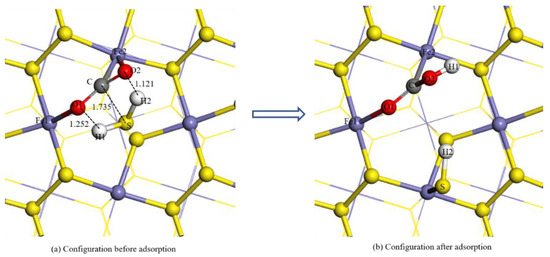
Figure 6.
Adsorption result of an isolated H2S molecule on the defective pyrite surface where a CO2 molecule is adsorbed. Note: the number represents the bond length in Å.
3.5. Co-Adsorption of H2S and CO2 Molecules on Pyrite Surface
During the origin of life, the reducing gases CO2 and H2S often coexisted on pyrite surfaces. What kind of interactions exist between them? The co-adsorption behaviors of H2S and CO2 molecules on the perfect and defective pyrite surface have been simulated. The results are shown in Figure 7.

Figure 7.
Co-adsorption result of H2S and CO2 molecules on the perfect and defective pyrite surface.
Previous research has reported that when H2O and O2 molecules co-adsorb on the perfect pyrite surface, they promote each other’s adsorption [14,15,19,21]. However, as shown in Figure 7a,b, the CO2 molecule slightly distorts and the distance between the O atom and the H atom is larger than expected based on their atomic radii. Furthermore, the adsorption energy of the co-adsorption of H2S and CO2 molecules on the pyrite surface is found to be higher compared to the adsorption of an isolated H2S molecule on the perfect pyrite surface. This suggests that the presence of CO2 molecules weakens the adsorption of H2S molecules on the perfect pyrite surface. In summary, the simulations indicate that the interactions between H2S and CO2 on the pyrite surface exhibit different characteristics compared to the co-adsorption of other molecules like H2O and O2. These findings provide insights into the complex interactions between reducing gases during the origin of life.
How co-adsorption behaviors of H2S and CO2 molecules on the pyrite surface differ in the presence of a S vacancy? The co-adsorption configuration of H2S and CO2 molecules on the defective pyrite surface containing the S vacancy is shown in Figure 7c,d. As shown in Figure 7c, when the H2S molecule dissociates to one –H and one –SH species without interacting with CO2, the adsorption energy is −197.55 kJ/mol. This value is similar to that of an isolated H2S molecule on the S vacancy defective pyrite surface, indicating that the CO2 molecule is not adsorbed in this case. Otherwise, as shown in Figure 7d, when the H2S molecule dissociates into two –H species and one –S species, the S vacancy is filled by the –S species, and the HCOOH is produced by combining two –H species and the CO2 molecule. This observation serves as a strong validation of reaction (1) mentioned earlier. Furthermore, the adsorption energy becomes more negative, indicating a highly favorable reaction.
To gain further insights into the reaction process of the co-adsorption of H2S and CO2 on the defective pyrite surface containing a S vacancy, a study of the transition state was conducted. Previous studies by Xiong et al. [39] and Wei et al. [40] have reported that the dissociation process of O2 requires overcoming an energy barrier. Figure 8 presents the result of the transition state for the co-adsorption of H2S and CO2 on the defective surface. It is observed that the H2S and CO2 molecules need to overcome an energy barrier (Ea) of 36.93 kJ/mol to generate the HCOOH molecule on the surface. Additionally, during the co-adsorption process, the H2S molecule first dissociates into two –H species and one –S species.
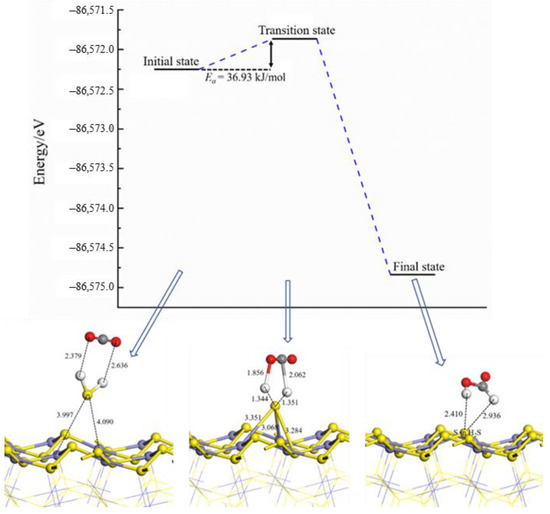
Figure 8.
Transition state of the dissociation of the H2S and CO2 molecules producing the HCOOH species.
In Figure S3, the atomic distances and the angle of ∠OCO are plotted to illustrate the changes in distances between atoms during the interaction process between molecules and the pyrite surface, as well as the interaction process between the molecules themselves. The optimization steps reflect the calculation process. As depicted in Figure S3, it can be observed that after four optimization steps, the bond lengths of the H1-S and H2-S bonds change to 1.689 Å and 1.704 Å, respectively. Additionally, the angle of ∠OCO changes to 137.881°. These changes indicate that both H2S and CO2 molecules undergo simultaneous dissociation, suggesting a concurrent dissociation process.
3.6. General Discussion
The findings of this study suggest that the adsorption energy of H2S, CO2, and the co-adsorption of H2S-CO2 on the defective surface is significantly lower than that on the perfect surface. This indicates that the presence of a S vacancy on the pyrite surface is favorable for the adsorption of H2S and CO2 molecules. According to Pan et al. [38], the defective surface is considered to be electron-rich and exhibits a higher electron-donating ability, which promotes the adsorption of molecules. As listed in Table 2, the number of electrons of dx2-y2, dxy, dzx, dzy, and dz2 in all five orbitals of the defective pyrite surface is larger than that of the perfect pyrite surface. Additionally, the change in Mulliken charge of the Fe1 atom with and without the presence of HCOOH is examined in Table 3. It can be observed that the Fe1 atom on the defective surface experiences a greater loss of charge compared to the Fe1 atom on the perfect surface. This suggests that the Fe atoms on the S vacancy defective pyrite surface have a stronger ability to lose electrons compared to those on the perfect surface. This finding is consistent with the conclusions of Pan et al. [38] and indicates that the reactivity of Fe atoms around the S vacancy is higher than that on the perfect surface. Therefore, based on the results presented in this study, it can be concluded that the reactivity of Fe atoms around the S vacancy is significantly higher compared to those on the perfect pyrite surface.

Table 2.
Number of electrons of d splitting orbitals of the Fe atom on the perfect and defective surface.

Table 3.
The Mulliken charge of Fe1 atom with and without formation of HCOOH.
Živković et al. [22] studied the adsorption behaviors of the CO2 molecule on the FeS (011) surface-terminated Fe atoms and also found the Fe–O and Fe–C bonds. The difference in Fe atoms between the pyrite surface and the FeS surface is the amount of coordination. Fe atoms on the FeS surface are bonded to three S atoms, while those on the pyrite surface are bonded to five S atoms. When the pyrite surface contains a S vacancy, the Fe atom on the pyrite surface changes to bond four S atoms. Hung et al. [24], Silva et al. [25], and Chen [26] studied the reactivity of Fe atoms on the surface of minerals that have different coordination numbers. They thought that the metal ion on the mineral surface is in a semi-constrained state and the interaction of the molecule with the mineral surface displays directivity, saturability, and steric effects. So, molecules preferentially react with sites of low Fe coordination. Therefore, we think that the Fe atom around the S vacancy which has four coordination sites is conducive to the adsorption of the H2S and CO2 molecules.
In addition, the schematic illustration for the change of CO2 and H2S into HCOOH is shown in Figure 9. As shown in Figure 9, it is found that the H2S and CO2 molecules need to gain electrons to be reduced to HCOOH. And the width of the band gap determines the ability of electron transfer. This is consistent with the findings of He et al. [12]. Therefore, the band gap of different surfaces was analyzed and is listed in Table 4. As listed in Table 4, the band gap of the perfect surface is 0.667 eV, which is close to the result obtained by Zhang et al. [41]. In addition, both Zhang et al. [41] and Cheng et al. [42] found that the existence of a defect obviously decreases the band gap of the pyrite surface. We also found the same experimental phenomenon. It can be seen from Table 3 that the bandgap of the defective surface where the CO2 molecule is the narrowest (0.199 eV), which is much smaller than the perfect surface, leads to a favorable dissociation of the H2S molecule and the production of the bicarbonate species (–COOH). In addition, the bandgap of the defective surface is far smaller than that of the perfect surface. After the co-adsorption of the H2S and CO2 molecules, the HCOOH molecule occurs. Therefore, it is the defective surface where the CO2 molecule is beneficial to the adsorption and the production of the HCOOH.
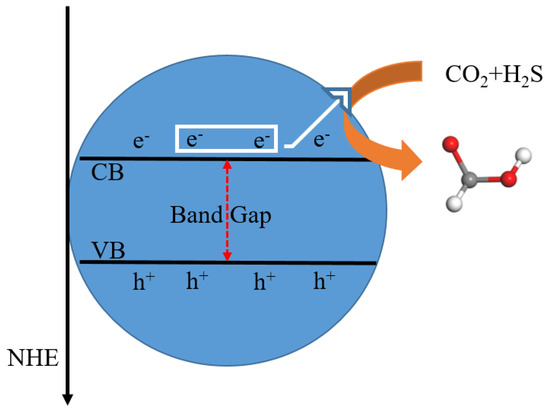
Figure 9.
Schematic illustration of the change of CO2 and H2S into HCOOH.

Table 4.
Band gap of different pyrite surfaces.
In further examining the effect of the adsorption sequence of H2S and CO2 on their co-adsorption behaviors, interesting findings were observed. For the case where CO2 is pre-adsorbed on the defective surface, it was found that the adsorption energy of the dissociated adsorption of H2S is only −57.51 kJ/mol, whereas, on a perfect surface, the adsorption energy is significantly higher at −196.18 kJ/mol. On the other hand, when H2S is pre-adsorbed on the defective surface, CO2 is unable to adsorb on the surface. This suggests that the adsorption of H2S or CO2 on the surface first is detrimental to the adsorption of the other molecule. However, in the case of co-adsorption, it was found that the HCOOH molecule is formed on the defective surface, and the adsorption energy is much lower compared to an isolated molecule. This indicates that the co-adsorption of H2S and CO2 promotes mutual adsorption and leads to the formation of the HCOOH molecule on the defective surface. Overall, these results highlight the importance of the adsorption sequence of H2S and CO2 and demonstrate that when co-adsorbed, they mutually enhance their adsorption behaviors, as indicated by the lower adsorption energy of the formed HCOOH molecule on the defective surface.
4. Conclusions
Based on the study using the DFT, the adsorption behavior of H2S and CO2 molecules on the surface of pyrite was investigated in this study. The findings revealed several important observations. Firstly, it was observed that on a defective pyrite surface containing a sulfur vacancy, the H2S molecule adsorbed and dissociated into –H and –SH species, which were found to be stable. The adsorption energy of the CO2 molecule on the same defective surface was calculated to be approximately −50 kJ/mol. Hence, the presence of a sulfur vacancy was found to be favorable for the adsorption of both H2S and CO2 molecules on the pyrite surface. Furthermore, the analysis of the adsorption sequence indicated that the pyrite surface adsorbed to by the H2S molecule cannot interact with the CO2 molecule. In contrast, when the CO2 molecule adsorbs on the pyrite surface after the adsorption of the H2S molecule, a bicarbonate species (–COOH) is formed. In the case of co-adsorption, interestingly, it was observed that the co-adsorption of H2S and CO2 led to the generation of the HCOOH molecule on the pyrite surface. The transition state analysis revealed that both H2S and CO2 molecules need to overcome an energy barrier (Ea) of 36.93 kJ/mol to form the HCOOH molecule on the surface. Additionally, the study investigated the dissociation process of the co-adsorption of H2S and CO2 molecules on the defective pyrite surface. It was found that both H2S and CO2 molecules undergo simultaneous dissociation.
Supplementary Materials
The following supporting information can be downloaded at: https://www.mdpi.com/article/10.3390/min13101292/s1, Figure S1: Adsorption configuration of an isolated CO2 molecule on the S-S site, S site, and Fe-Fe site of the perfect pyrite surface. Note: The number denotes the bond length in Å; Figure S2: Adsorption configuration of an isolated CO2 molecule on the defective pyrite surface where adsorbed the H2S molecule. Note: The number denotes the bond length in Å; Figure S3: Complete dissociation process of H2S and CO2 on defective pyrite surface containing S vacancy.
Author Contributions
Writing—original draft, Y.L. (Yingchao Liu); Writing—review & editing, Y.L. (Yuqiong Li); Investigation, Y.F.; Supervision, J.C. and C.Z. All authors have read and agreed to the published version of the manuscript.
Funding
This research was funded by the National Natural Science Foundation of China (NSFC) (grant numbers U20A20269, 52364023, and 51964004) and the Major Science and Technology Projects in Yunnan Province (grant number 202202AB080012).
Data Availability Statement
The data presented in this study can be obtained by contacting the corresponding author.
Acknowledgments
We are grateful to the National Natural Science Foundation of China and the high-performance computing platform of Guangxi University. We thank anonymous reviewers for their thoughtful and thorough suggestions/reviews and editorial efforts, which greatly assisted in the improvement of this manuscript.
Conflicts of Interest
The authors declare no conflict of interest.
References
- Li, H.H.; Li, C.X.; Han, L.J.; Li, C.S.; Zhang, S.J. Photocatalytic reduction of CO2 with H2O on CuO/TiO2 catalysts. Energ. Sources Part A 2016, 38, 420–426. [Google Scholar] [CrossRef]
- Mori, K.; Yamashita, H.; Anpo, M. Photocatalytic reduction of CO2 with H2O on various titanium oxide photocatalysts. RSC Adv. 2012, 2, 3165–3172. [Google Scholar] [CrossRef]
- Dong, Y.P.; Nie, R.; Wang, J.X.; Yu, X.G.; Tu, P.C.; Chen, J.Z.; Jing, H.W. Photoelectrocatalytic CO2 reduction based on metalloporphyrin-modified TiO2 photocathode. Chin. J. Catal. 2019, 40, 1222–1230. [Google Scholar] [CrossRef]
- Zhang, X.Y.; Li, Q.; Simon, M.; Zheng, G.D.; Tan, Y.S. Effect of H2S content on relative permeability and capillary pressure characteristics of acid gas/brine/rock systems: A review. J. Rock Mech. Geotech. 2022, 14, 2003–2033. [Google Scholar] [CrossRef]
- Kvamme, B.; Iden, E.; Tveit, J.; Veland, V.; Zarifi, M.; Qorbani, K. Effect of H2S Content on Thermodynamic Stability of Hydrate Formed from CO2/N2 Mixtures. J. Chem. Eng. Data 2017, 62, 1645–1658. [Google Scholar] [CrossRef]
- Lu, A.H.; Li, Y.; Li, Y.Z.; Ding, H.R.; Wang, C.Q. The role of mineral photoelectron energy in the origin and evolution of early life on the Earth. Geol. Rev. 2023, 69, 234–246. (In Chinese) [Google Scholar] [CrossRef]
- Li, Y.Z.; Li, Y.; Liu, Y.; Wu, Y.F.; Wu, J.Q.; Wang, B.; Ye, H.; Jia, H.N.; Wang, X.; Li, L.H.; et al. Photoreduction of inorganic carbon(+IV) by elemental sulfur: Implications for prebiotic synthesis in terrestrial hot springs. Sci. Adv. 2020, 6, 3687. [Google Scholar] [CrossRef] [PubMed]
- Sharma, L.; Upadhyay, R.; Rangarajan, S.; Baltrusaitis, J. Inhibitor, Co-Catalyst, or Co-Reactant? Probing the Different Roles of H2S during CO2 Hydrogenation on the MoS2 Catalyst. ACS Catal. 2019, 9, 10044–10059. [Google Scholar] [CrossRef]
- Ennaoui, A.; Fiechter, S.; Pettenkofer, C.; Alonso-Vante, N.; Büker, K.; Bronold, M.; Höpfner, C.; Tributsch, H. Iron Disulfide for Solar-Energy Conversion. Sol. Energy Mater. Sol. Cells 1993, 29, 289. [Google Scholar] [CrossRef]
- Zhang, X.V.; Ellery, S.P.; Friend, C.M.; Holland, H.D.; Michel, F.M.; Schoonen, M.A.A.; Martin, S.T. Photodriven reduction and oxidation reactions on colloidal semiconductor particles: Implications for prebiotic synthesis. J. Photochem. Photobiol. 2007, 185, 301–311. [Google Scholar] [CrossRef]
- Scribano, V.; Simakov, S.K.; Finocchiaro, C.; Correale, A.; Scirè, S. Pyrite and Organic Compounds Coexisting in Intrusive Mafic Xenoliths (Hyblean Plateau, Sicily): Implications for Subsurface Abiogenesis. Origins Life Evol. B 2019, 49, 19–47. [Google Scholar] [CrossRef] [PubMed]
- He, R.T.; Hu, B.Y.; Zhong, H.; Jin, F.M.; Fan, J.J.; Hu, Y.H.; Jing, Z.Z. Reduction of CO2 with H2S in a simulated deep-sea hydrothermal vent system. Chem. Commun. 2019, 55, 1056. [Google Scholar] [CrossRef] [PubMed]
- Liu, X. Hydrogenation of CO2 Promoted by Silicon Activated H2S: Origin and Implications. Molecules 2021, 26, 50. [Google Scholar] [CrossRef]
- Li, Y.Q.; Chen, J.H.; Chen, Y.; Zhao, C.; Zhang, Y.B.; Ke, B.L. Interactions of Oxygen and Water Molecules with Pyrite Surface: A New Insight. Langmuir 2018, 34, 1941–1952. [Google Scholar] [CrossRef] [PubMed]
- Sit, P.H.L.; Cohen, M.H.; Selloni, A. Interaction of Oxygen and Water with the (100) Surface of Pyrite: Mechanism of Sulfur Oxidation. J. Phys. Chem. Lett. 2012, 3, 2409–2414. [Google Scholar] [CrossRef]
- Chen, J.H.; Long, X.H.; Chen, Y. Comparison of Multilayer Water Adsorption on the Hydrophobic Galena (PbS) and Hydrophilic Pyrite (FeS2) Surfaces: A DFT Study. J. Phys. Chem. C 2014, 118, 11657–11665. [Google Scholar] [CrossRef]
- Hu, J.; Zhang, Y.; Law, M.; Wu, R.Q. First-Principles Studies of the Electronic Properties of Native and Substitutional Anionic Defects in Bulk Iron Pyrite. Phys. Rev. B 2012, 85, 085203. [Google Scholar] [CrossRef]
- Nair, N.N.; Schreiner, E.; Marx, D. Glycine at the Pyrite-Water Interface: The Role of Surface Defects. J. Am. Chem. Soc. 2006, 128, 13815–13826. [Google Scholar] [CrossRef]
- Liu, Y.C.; Li, Y.Q.; Chen, J.H.; Kang, D.; Yang, X. Influence of sulfur vacancy on pyrite oxidization by water and oxygen molecules. Colloid Surface A 2022, 634, 127954. [Google Scholar] [CrossRef]
- Stirling, A.; Bernasconi, M.; Parrinello, M. Ab initio simulation of H2S adsorption on the (100) surface of pyrite. J. Chem. Phys. 2003, 119, 4934–4939. [Google Scholar] [CrossRef]
- Stirling, A.; Bernasconi, M.; Parrinello, M. Ab initio simulation of water interaction with the (100) surface of pyrite. J. Chem. Phys. 2003, 118, 8917–8926. [Google Scholar] [CrossRef]
- Živković, A.; Somers, M.; Camprubi, E.; King, H.E.; Wolthers, M.; de Leeuw, N.H. Changes in CO2 Adsorption Affinity Related to Ni Doping in FeS Surfaces: A DFT-D3 Study. Catalysts 2021, 11, 486. [Google Scholar] [CrossRef]
- Kolos, M.; Tunega, D.; Karlicky, F. Theoretical study of adsorption on iron sulfides towards nanoparticles modeling. Phys. Chem. Chem. Phys. 2020, 22, 23258–23267. [Google Scholar] [CrossRef] [PubMed]
- Hung, A.; Muscat, J.; Yarovsky, I.; Russo, S.P. Density-functional theory studies of pyrite FeS2 (100) and (110) surfaces. Surface Sci. 2002, 513, 511–524. [Google Scholar] [CrossRef]
- Silva, J.C.M.; dos Santos, E.C.; Heine, T.; Abreu, H.A.D.; Duarte, H.A. Pyrite oxidation mechanism by Oxygen in Aqueous Mediun. J. Phys. Chem. C 2016, 120, 2760–2768. [Google Scholar] [CrossRef]
- Chen, J.H. Coordination Principle of Minerals Flotation; Science Press Beijing: Beijing, China, 2022; pp. 157–213. [Google Scholar]
- Clark, S.J.; Segall, M.D.; Pickard, C.J.; Hasnip, P.J.; Probert, M.I.J.; Refson, K.; Payne, M.C. First principles methods using CASTEP. Z. Krist. 2005, 220, 567–570. [Google Scholar] [CrossRef]
- Segall, M.; Lindan, P.J.D.; Probert, M.; Pickard, C.J.; Hasnip, P.J.; Clark, S.J.; Payne, M.C.J. First-principles simulation: Ideas, illustrations and the CASTEP code. J. Phys. Condens. Mater. 2002, 14, 2717–2744. [Google Scholar] [CrossRef]
- Vanderbilt, D. Soft self-consistent pseudopotentials in a generalized eigenvalue formalism. Phys. Rev. B 1990, 41, 7892–7895. [Google Scholar] [CrossRef] [PubMed]
- Zhang, M.Y.; Jiang, H. Accurate Prediction of Band Structure of FeS2: A Hard Quest of Advanced First-Principles Approaches. Front. Chem. 2021, 9, 747972. [Google Scholar] [CrossRef]
- Halgren, T.A.; Lipscomb, W.N. The synchronous-transit method for determining reaction pathways and locating molecular transition states. Chem. Phys. Lett. 1977, 49, 225–232. [Google Scholar] [CrossRef]
- Li, Y.Q.; Chen, J.H.; Chen, Y.; Guo, J. Density functional theory calculation of surface properties of pyrite (100) with implications for flotation. Chin. J. Nonferrous Met. 2011, 21, 919–926. [Google Scholar]
- Guevremont, J.M.; Strongin, D.R.; Schoonen, M.A.A. Thermal chemistry of H2S and H2O on the (100) plane of pyrite: Unique reactivity of defect sites. Am. Mineral. 1998, 83, 1246–1255. [Google Scholar] [CrossRef]
- Li, S.F.; Guo, Z.X. CO2 activation and total reduction on titanium (0001) surface. J. Phys. Chem. C 2010, 114, 11456–11459. [Google Scholar] [CrossRef]
- Mishra, A.K.; Roldan, A.; de Leeuw, N.H. CuO surfaces and CO2 activation: A dispersion-corrected DFT+ U study. J. Phys. Chem. C 2016, 120, 2198–2214. [Google Scholar] [CrossRef]
- Khaledialidusti, R.; Mishra, A.K.; Barnoush, A. CO2 Adsorption and Activation on the (110) Chalcopyrite Surfaces: A Dispersion-Corrected DFT + U Study. ACS Omega 2019, 4, 15935–15946. [Google Scholar] [CrossRef] [PubMed]
- Wu, H.W.; Zhang, N.; Wang, H.M.; Hong, S.G. Adsorption of CO2 on Cu2O (111) oxygen-vacancy surface: First-principles study. Chem. Phys. Lett. 2013, 568–569, 84–89. [Google Scholar] [CrossRef]
- Pan, Y.X.; Liu, C.J.; Mei, D.H.; Ge, Q.F. Effects of hydration and oxygen vacancy on CO2 adsorption and activation on β-Ga2O3 (100). Langmuir 2010, 26, 5551–5558. [Google Scholar] [CrossRef]
- Xiong, X.L.; Hua, X.M.; Zheng, Y.F.; Lu, X.G.; Li, S.G.; Cheng, H.W.; Xu, Q. Oxidation mechanism of chalcopyrite revealed by X-ray photoelectron spectroscopy and first principles studies. Appl. Surf. Sci. 2018, 427, 233–241. [Google Scholar] [CrossRef]
- Wei, Z.L.; Li, Y.B.; Gao, H.M.; Zhu, Y.G.; Qian, G.J.; Yao, J. New insights into the surface relaxation and oxidation of chalcopyrite exposed to O2 and H2O: A first-principles DFT study. Appl. Surf. Sci. 2019, 492, 89–98. [Google Scholar] [CrossRef]
- Zhang, Y.N.; Hu, J.; Law, M.; Wu, R.Q. Effect of surface stoichiometry on the band gap of the pyrite FeS2(100) surface. Phys. Rev. B 2012, 85, 085314. [Google Scholar] [CrossRef]
- Cheng, W.; Cheng, C.; Ke, B.L. The Effect of Carbon Defects in the Coal–Pyrite Vacancy on the Electronic Structure and Optical Properties: A DFT + U Study. Minerals 2020, 10, 815. [Google Scholar] [CrossRef]
Disclaimer/Publisher’s Note: The statements, opinions and data contained in all publications are solely those of the individual author(s) and contributor(s) and not of MDPI and/or the editor(s). MDPI and/or the editor(s) disclaim responsibility for any injury to people or property resulting from any ideas, methods, instructions or products referred to in the content. |
© 2023 by the authors. Licensee MDPI, Basel, Switzerland. This article is an open access article distributed under the terms and conditions of the Creative Commons Attribution (CC BY) license (https://creativecommons.org/licenses/by/4.0/).